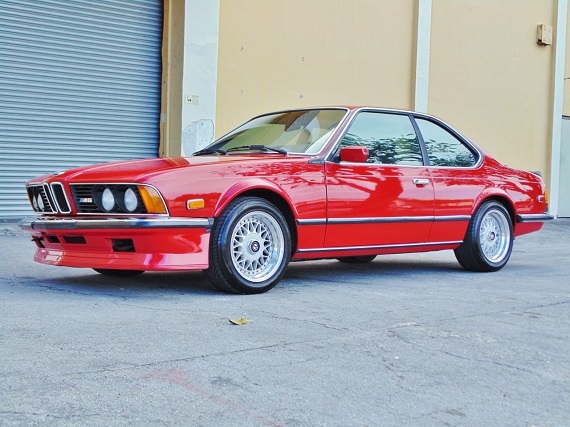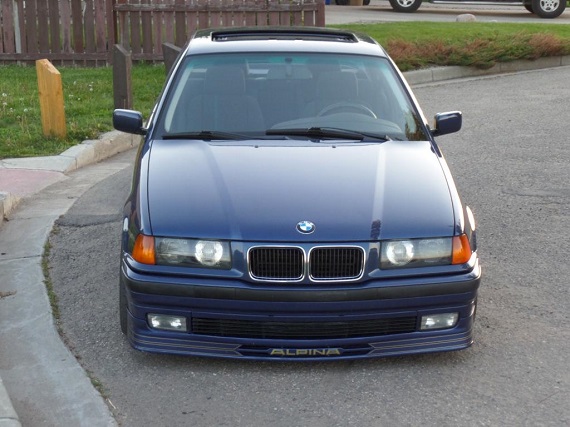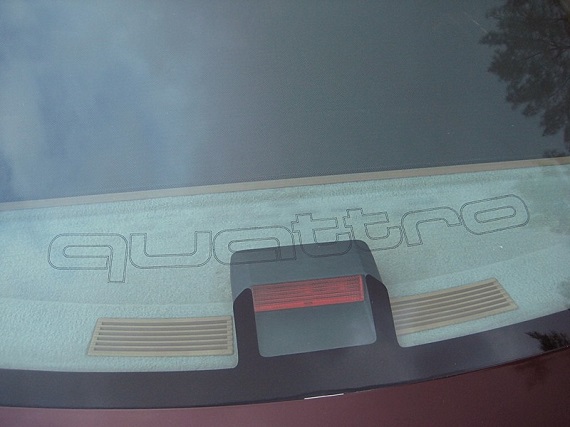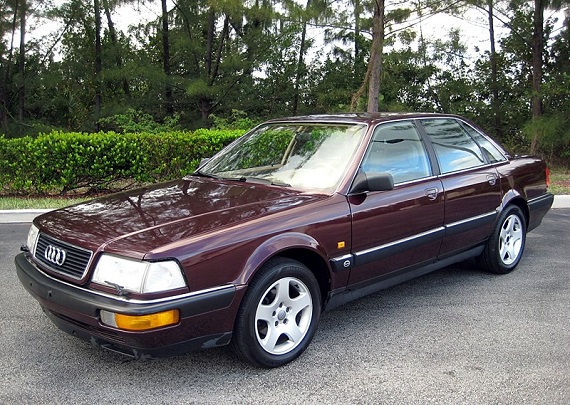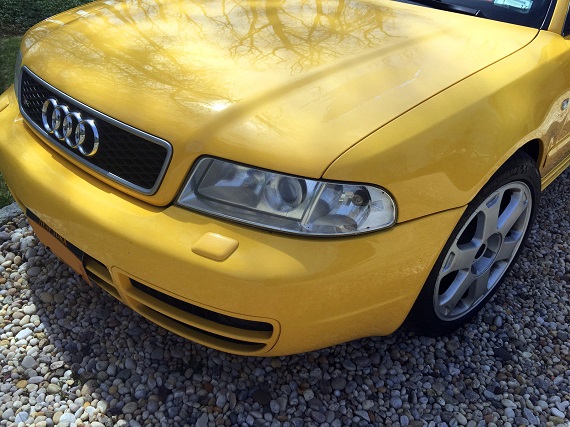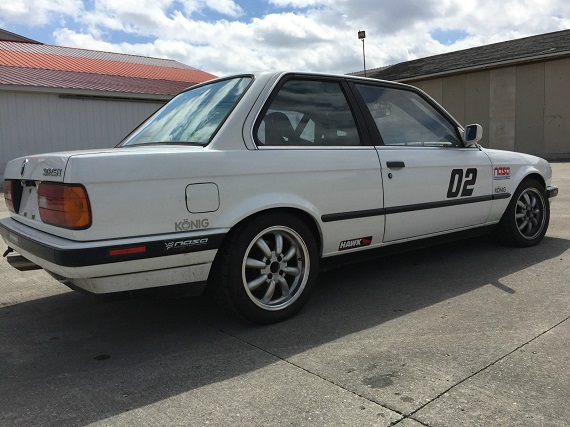An odd reversal has occurred in the BMW world; go back even five years and the car from the 1980s – outside of the M1 – was the M6. Now, oddly, the M6 may be the best value going in Motorsport BMWs from the 1980s. What caused the turn around? Well, it certainly had little to do with the M6, and probably more to do with the inevitable acknowledgement that the more rare M5 was a great car too, and the E30 has equally gained status as – effectively – a 911 replacement. So the M6, the grandest of BMW’s grand touring lineup, has become relatively affordable for the performance level offered. The extra benefit of it’s high residual price has been that most have been kept in excellent condition overall; while it’s normal to see highly modified or ratty M3s and M5s, finding pristine M6s almost seems cliche; odd, considering the relatively low number produced. Even more affordable than the later M6s was the M6 prototype; the M635CSi. While never imported to the U.S., a fair amount made it here through the grey market long before the M products debuted in this market. With an even more potent version of the inline-6, the M1-detuned M88/3, coupled with lower weight, these early M6s were even more impressive performers than the later cars. However, unlike the later M6s, finding clean and unmolested M635CSis is more difficult as lower residual value on the grey market cars meant they were sometimes neglected or more heavily modified:
Author: Carter
While Ruf and AMG grab most of the big tuner headlines from Germany, Alpina quietly and competently produced some of the wildest and best executed BMWs ever made. Simply put, Alpina made already good BMWs better – and arguably still do today. One of the most interesting aspects of the company is the close working relationship they have with the factory; a partnership which results in truly special treatment. Take the Alpina B8 for example; any normal tuner might have simply enlarged the inline-6 under the hood of the already potent M3. Or, in the tradition of the 1980s Alpinas, they could have turbocharged the engine. But instead Alpina asked BMW to make them a special V8. And, somewhat surprisingly, BMW did – a new block was designed for Alpina since the normal 4.0 couldn’t be bored out. The result was a 4.6 liter motor which was fit to the B8 4.6 and B10 as well. The motor was so large in the E36 that a special oil pan had to be designed, and neatly a German camera maker had to be employed to design and build a special oil pump to run it. Yet in true Alpina tradition, the fit and finish was factory and accompanied a host of suspension, interior and aerodynamic tweaks. Capped off by special Alpina paint, these B8s are truly special E36s. While the B8 4.6 is the headline grabber, Alpina built a short run of 5…or perhaps 6….4 liter models that were sold in Japan:
CLICK FOR DETAILS: 1996 Alpina B8 on Bimmerforums
6 CommentsI have a fun ongoing exchange with our reader John; we send each other pretty much every V8 quattro that comes to the market in the U.S., usually accompanied by some brutally honest and laughable one-liner. Considering the number of V8 quattros imported – less than 4000 – and that they were both expensive and a DTM star, they would have been coveted like the rest of the Audi lineup. Yet, many have fallen into extreme disrepair or neglect, leaving precious few left running today and making good ones a rare find. For example, recently John sent me a pretty worn Pearlesant White ’93 model with the line: ” ‘cheap’ and haven’t seen it before, but that’s about it”. I responded that I’d done the “cheap” V8 route before, and that were I to do it again I would have been better off spending three times as much to get a maintained example. The V8 is truly a car that could bankrupt you trying to restore a poor one to original condition. However, if you find a reasonable example that’s well priced, is it a better proposition?
CLICK FOR DETAILS: 1990 Audi V8 quattro on eBay
1 CommentFor some time, the B5 S4 was dismissed by a fair amount of enthusiasts as a heavy, complicated car. Truth told, the B5 seemed a bit of a let down initially compared to the already gone and instantly legendary C4 S4/S6 with the venerable inline-5 power plant. But Audi had a new range of motors when it came to the B5, and the inline-5 did not really fit under the more compact hood in the lineup. Replacing the single turbo 5-pot was a new 2.7 liter V6 with not one but two turbochargers. Despite that, performance seemed a bit tame; 250 horsepower was nothing to sneeze at, but it was only a bit more than the outgoing M3, after all. However, the B5 had a few trump cards over its competition. Of course, the major one was that quattro all-wheel drive continued to be the high-performance platform for Audi. In this guise, the lockable options were completely removed from the driver, instead having the computer’s brain work electronically locking differentials coupled with electronic stability. While the combination of these things didn’t sound like an enthusiast’s dream, out of the box the S4 was a quite competent performer. Of course, the big bonus with turbocharging was that there was a tremendous amount of performance potential on tap with some upgrades. Free up the exhaust and turn up the boost, and these Teutonic turbocharged wonders went from tame to terror. There was one other major trump card the B5 had over the competition; as with the last of the run C4 S6s, Audi finally allowed their fast wagons to come over to these shores. They were an instant hit amongst the Audi faithful, and brought many more customers over to the four rings from other marques as well. Arguably the most popular were the two wild color options; the ever popular purple-blue Norgaro Blue and the retina-searing shade of Imola Yellow. Only a reported 64 Imola Yellow Avants were imported between 2001 and 2002, making it one of the more rare B5s produced. Paired with a 6-speed manual gearbox, these Avants have stood the test of time and are still highly sought by enthusiasts:
CLICK FOR DETAILS: 2001 Audi S4 Avant on eBay
1 CommentA funny thing happens when you go to the track often. People arrive with generally a slower car in stock form. The immediate experience most have, once hooked on heading to the track, is that their driving is not the limiting factor, but the speed of their car. So the story goes, with searches of the internet resulting in stiffer suspension, chips and exhaust, engine mapping and dyno runs, camber plates and coil-overs, sticky rubber and the lightest wheels possible – even if they’re ugly. Why? All in the quest of speed. However, once those drivers get towards the top, a few strange realizations occurs: first, there will always be someone with more money (often, a lot more) who will turn up at the track with a weapon capable of making your turned up and tuned up ride look positively slow. The second is more profound – the guys in the slow cars are coming off track with bigger smiles. It’s simply very satisfying to drive a slow car fast, and it turns out that those drivers get closer to the edge and experience a more pure driving experience. Anyone can plunk down $110,000 at your Nissan dealership and go and let the car set fast lap times. But it takes panache to take a step back and enjoy an older, slower car – to hone your skills and make yourself a better driver. While there are several cars from the 1980s that will afford you that opportunity, arguably the most popular in the German car realm is the venerable E30:

